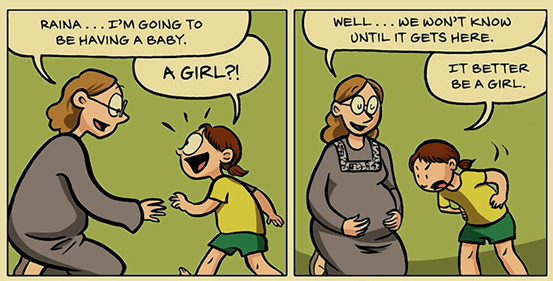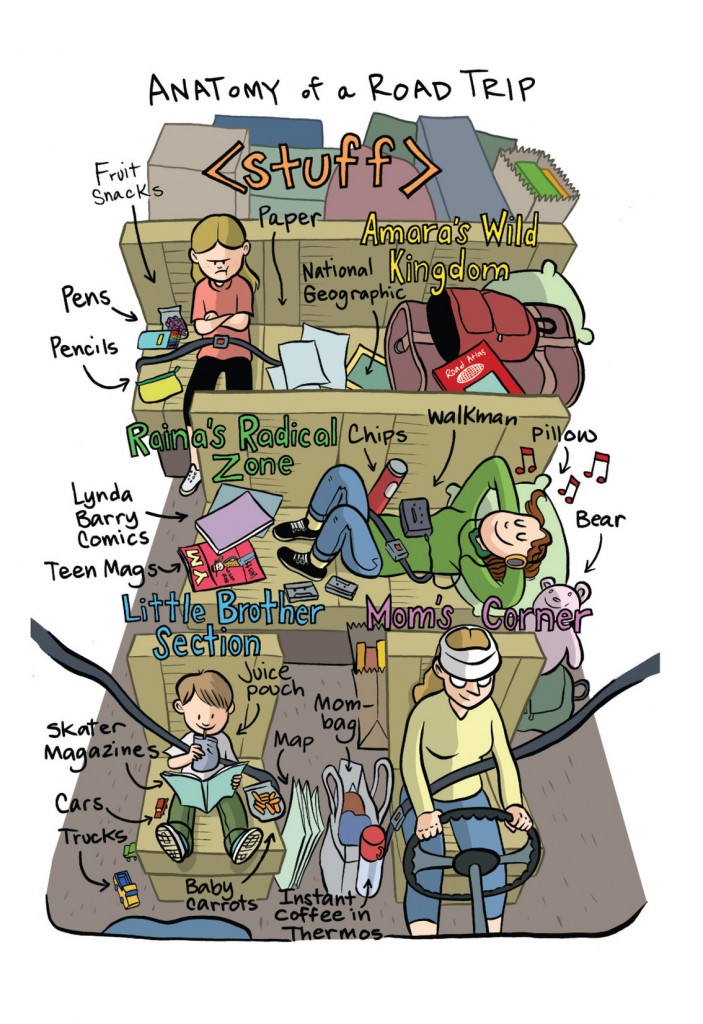Sisters is the autobiographical recounting of author Raina Telgemeier’s three week cross-country road trip with her mother, brother, and sister in the summer before Raina enters high school. During this trip tempers flare, break-downs occur, and we’re afforded a close look at the relationship between Raina and her sister Amara, achieved through the use of well-placed flashbacks. Throughout the book, Raina presents this dysfunctional relationship in the context of a larger family dynamic, all the while refusing to give easy answers about the nature of sibling rivalries. In this way, Raina does not paint herself as the hero of this piece, letting the narrative and events speak for themselves instead.
The road trip structure was a wise choice for this book, as it allows the family to be isolated, literally forcing the young characters into tight spaces, all while using flashbacks as a way to open the narrative up and allow it to breathe. When we first meet Raina, she and her family are eating dinner together right before the road trip starts. Her father checks and re-checks that her mother has packed everything (he’ll take a plane to the family reunion later on), while Raina and her sister bicker. By the time they’re clearing their plates, Raina is annoyed enough to shout “Why did I ever ask for a sister?” and we’re launched into the first flashback. The flashbacks are often transitioned in this way, taking a moment of dialogue or an image to spring-board off of, mirroring the organic way memories come to mind.
Teenage Raina secretly packs a case of colored pencils for the road trip after denying the existence of those pencils to her sister, and suddenly we flashback to a young Raina trying to connect with her baby sister over and over and failing, until Amara discovers that she, too, loves to draw. This is maybe my favorite section in the whole book: Raina wants Amara to draw with her at the table, but all Amara wants to do is color on the floor. Their mother gets involved and tries to make Amara draw with her sister, and Amara pitches a fit. “You can sit wherever you want to,” says a perplexed Raina. “I don’t care. Whatever makes you happy.” And Amara begrudgingly moves to the table, though she refuses to interact with her sister in any other way. This is a story of a series of olive branches extended and redacted, caught hold of and thrown back in the other’s face.
Communication, and the failure to communicate, is the theme that runs throughout this entire book. You get the feeling reading this that the sisters might just get along better if they could trust one another to open up emotionally. This seems to be the great tragedy of the relationship: that neither really knows how to communicate with the other. Both sisters can’t seem to make it through a conversation without unintentionally provoking the other, and Raina spends most of the road trip listening to her Walkman and tuning out the rest of the family. In fact, the truly emotional moments in this book come from when the sisters stop talking entirely. Early in the road trip the family sees a pair of deer grazing on the side of the road. Amara jumps out, yelling at everyone else to be quiet. She approaches the deer with a little heart above her head, transfixed. Raina follows her, completely silent, and the two sisters watch the deer, mere feet from the two of them. It’s a peaceful moment in a book dominated by loud, disruptive scenes.
Another one of these quiet scenes plays out on the second half of the trip, as the family is heading back to their home. When the car breaks down in the middle of the desert, Raina’s mother and brother are forced to hitchhike several hours back to the nearest town, leaving Raina and Amara alone in the van. The sisters spend most of their time ignoring each other, with Raina listening to her music and Amara reading. Eventually, though, the two annoy each other and end up in a fight, which climaxes with the two of them broaching the subject of their parents’ relationship, and the fact that the two haven’t been getting along for a while. In fact, the real reason their father didn’t join them on the trip was because their mother asked him not to, as she needed space from him for a while. The two sisters suddenly have to grapple with the idea that their parents might get a divorce. This page is unusually quiet for the book, and their fear and uncertainty is all the clearer for it. For me, someone who had to deal with her parents’ divorce at the same age that Raina is in this book, this scene lands emotionally, but also creates a feeling of hope. Raina and Amara are sisters at the end of the day, and they are capable of providing comfort for each other, even if they spend most of their time trapped in petty arguments. This moment, with the two coming together for the first time, makes the ending especially gratifying, as Raina is able to control her fears for long enough to make her sister happy.
The flaw of Sisters is in the lack of reflection and introspection. This isn’t a treatise on all sisterly relationships everywhere; it’s a story about a very specific pair of sisters in a very specific family. Still, by the end of the book, I’m left feeling as though there’s something missing. Sisters isn’t an attempt to delve into this relationship as much as it is a recounting of events. Flashbacks are more often included because they offer exposition and context for the various situations the characters are in, rather than providing thematic consistency or any sort of analytical background. There’s a missed opportunity for the author to offer a reflection on this relationship, rather than just presenting the events as they happened. I can’t help but think that an older Telgemeier acting as a narrator would have given the novel’s events more nuance. That being said, the story handles its subject with great care and deftness, letting the reader find her own patterns and come to her own conclusions. In this way, maybe the story is more relatable for its younger audience.
The artwork, perhaps, is also better suited for a younger readership. The cartoonish style (with exaggerated facial expressions and bulging eyes) works surprisingly well within the tone of the book. While the subject is sometimes serious (dealing with unemployment and possible divorce), there is usually a joke to break the tension, making the moments when humor disappears from the narrative all the more effective. The animated artwork is especially suited to Amara, whose outbursts lend themselves well to a cartoon depiction. Telgemeier’s landscapes are beautiful, illustrating landmarks along the road trip in what are basically chapter breaks.
Sisters is a great introduction to comics memoir for young adults, offering an honesty that doesn’t speak down to its readers. Raina Telgemeier presents a complicated relationship in as unbiased a way as possible, refusing to pull punches when it comes to her own actions, as well as refusing to demonize her own sister. Sisters isn’t quite as deep or analytical a memoir as it could be, but it it’s a great first stepping stone for younger readers, encouraging them to explore deeper waters.
Sisters is available now from Scholastic.





Why made u become a writer and why?
I also love that book
Please write more books:)